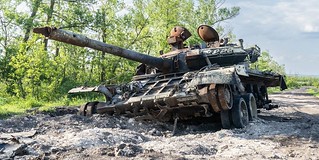The cockpit interior of the still mysterious F-117 Nighthawk stealth attack aircraft
During the 1980s, one of the most intense rumors in the aviation world concerned a secret radar-invisible aircraft.
For years there has been talk of an alleged Project Aurora and a possible aircraft, called the F-19, which the United States had secretly developed at Skunk Works, the secret wing of Lockheed Martin. The possible existence of these projects was in fact a diversionary operation to hide a real project: the F-117 Nighthawk, an aircraft whose name was in itself misleading, since the initial F for Fighter is reserved in the US Air Force (USAF) for aircraft intended to intercept other aircraft, but the F-117 was an attack aircraft, incapable of carrying out air-to-air missions.

Finally, on November 10, 1988, the Pentagon revealed the first image of the F-117 at a press conference, through a black and white photo that baffled many, since it was an angular-shaped aircraft that bore little resemblance to the supposed rounded shapes that had circulated in speculation about the possible F-19. Just a few days later, another stealth aircraft was officially presented on November 22, 1988 in Palmdale, California: the B-2 Spirit bomber. The existence of these aircraft led to the question of whether many alleged UFO sightings had in fact been sightings of these secret aircraft.

The F-117 was closely guarded for years. Its first flight took place on June 18, 1981, at the Groom Lake Test Range in Nevada, popularly known as Area 51 (another secret project development site traditionally associated with UFO sightings). The aircraft entered service in 1983. Five prototypes and 59 production aircraft were built, and they were first used in combat in the Gulf War in 1991. The aircraft’s angular shapes were designed to reduce its radar signature, offering an echo smaller than that of a bird.

Due to its stealthy nature and unusual design, the F-117 was a subsonic aircraft. It had two General Electric F404 turbofan engines, the same model as the F/A-18 Hornet, but the F-117 had them installed without afterburners to reduce the aircraft's infrared signature.

As for armament, the F-117 has two weapons bays capable of carrying one bomb each, both laser-guided bombs like the GBU-12 Paveway II and GPS-guided bombs GBU-31 JDAM. It is also capable of carrying two B-61 thermonuclear bombs, with a capacity of up to 340 kilotons (the Hiroshima bomb was 16 kilotons). The weapons bays open quickly to drop the bombs and close immediately, since opening them suddenly increases the aircraft's radar signature.

So far, the USAF has only lost one F-117 in an attack on Serbia in 1999, shot down by an S-125 missile. The pilot, Lt. Col. Darrell Patrick "Dale" Zelko, managed to eject and was rescued by the USAF. The wreckage of this aircraft, serial number 82-0806 and nicknamed "Something Wicked," is preserved at the Belgrade Aviation Museum. After this incident, the fate of the F-117 seemed sealed. The entry into service of the F-22 and F-35 precipitated its premature end. The F-117 was originally scheduled to remain in service until 2011, but the pilot training program for this aircraft was cancelled in 2006 and the F-117 made its last official flight on March 12, 2007.

However, the F-117's supposed retirement is controversial. Almost the entire fleet was stored at the Tonopah test site, as some of the aircraft's characteristics remained classified. Some F-117s ended up in museums, but the USAF continued to fly the aircraft, raising the question of how far it was actually retired from service, and the F-117 remains shrouded in mystery today.

A few days ago, Paul Stewart posted an interesting video showing the interior of the cockpit of the F-117 preserved at the Palm Springs Air Museum, the 85-0833 Black Devil, an aircraft that has been restored after undergoing a process in which the parts that are still classified were removed:
---
Main photo: U.S. Air National Guard. An F-117 landing at Fresno-Yosemite International Airport, California, on September 15, 2021.
|
Don't miss the news and content that interest you. Receive the free daily newsletter in your email: |
- Most read
- Russian forces have already lost more than 10,000 armored vehicles in Ukraine
- The new Frecce Tricolori planes and their new design, a work of Pininfarina
- The National Museum of Science and Technology of La Coruña and the Boeing 747 inside it
- Eurofighter vs F-35: the opinions of professional pilots on these advanced fighters
- The firearms used by the Pontifical Swiss Guard, the smallest army in the world
- Sierra Army Depot, a huge United States base with hundreds of Abrams tanks stored
- The problems of the VH-92A Patriot, the new US Marine One presidential helicopter

 ES
ES







Opina sobre esta entrada: